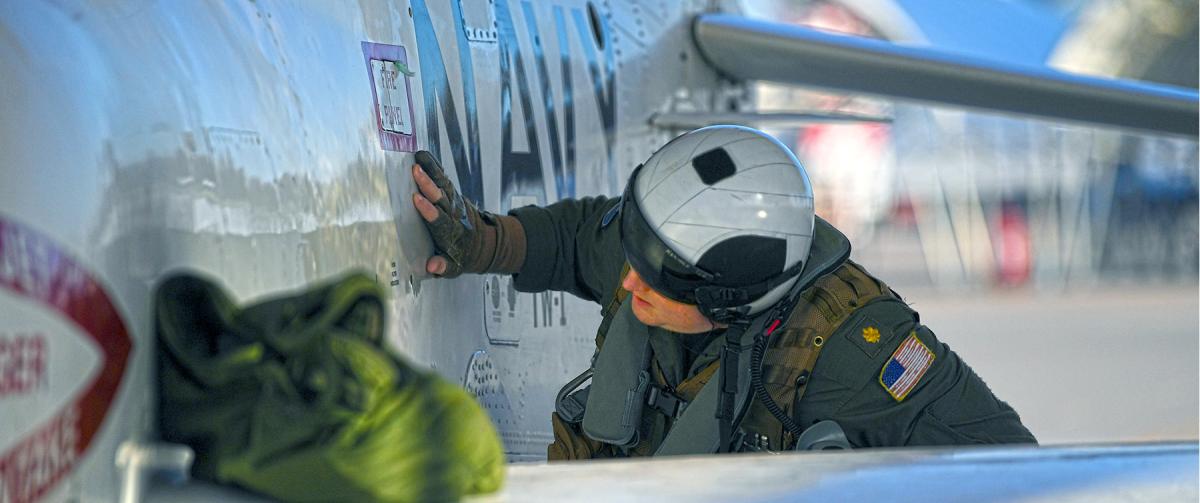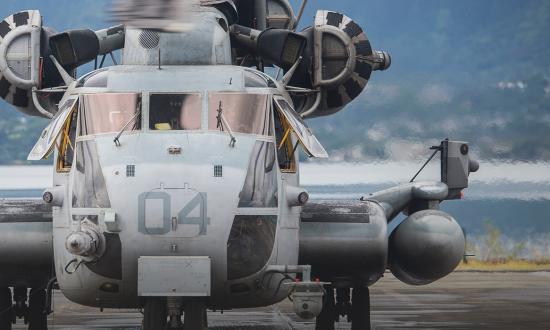A pilot looks at an aircraft discrepancy book before every flight, thoroughly reviewing any issues the aircraft faces. It is the pilot’s responsibility to refuse to accept an aircraft that is not safe to operate. In cases with faulty aircraft and equipment, lower-level leaders are empowered to decide that short-term operational goals are not worth the risk to personnel and equipment. In 2017, after noting safety issues in the T-45 Goshawk trainer jets, several instructor pilots refused to take the aircraft and their students up in the air. The incident drew the attention of high-ranking admirals within naval aviation, and all T-45 aircraft were grounded across the fleet while engineers and pilots completed a safety review. The grounding of the T-45 fleet halted a critical training pipeline and drew a significant amount of press attention. However, these junior officers likely prevented a worse outcome. The grounding of the T-45 fleet halted a critical training pipeline and drew a significant amount of press attention. However, these junior officers likely prevented a worse outcome. In addition to risking the lives of students and instructors, a serious crash would have damaged the Navy’s training pipeline and commanded even more negative attention from the media. The Navy and Marine Corps must empower leaders at all levels to be able to raise readiness issues to senior leaders, communicate concerns about training and equipment, and decline to accept risks not justified by operational necessity.
In recent years, several tragic incidents that claimed the lives of sailors and Marines could have been prevented if seniors paid attention to junior leaders who communicated operational readiness concerns. In December 2018, a Marine Corps F/A-18 Hornet and KC-130 refueling aircraft collided in a nighttime training exercise, killing six Marines. An initial investigation into the incident cited the inexperience of the Hornet pilot, the use of medications by the F/A-18’s weapons systems officer, and the command’s complacency as the main causes of the crash. A later review of the investigation, however, overturned many of these findings. The review concluded that the pilot erred by performing a nonstandard refueling maneuver and confirmed that the lax command climate was a contributing factor to the crash.
Despite these mistakes, several institutional issues were causal factors in this accident. The drug Ambien is regularly prescribed to fatigued aviators to help them rapidly adjust their sleep patterns between daytime and nighttime operations. The weapons systems officer’s use of this sedative reflected the intense physiological demands he faced even in a routine training exercise. The night-vision goggles used by the pilot were so prone to malfunctions that the Air Force, unlike the Marine Corps, recommended its airmen not use the devices. The squadron’s commanding officer had sent several warnings highlighting the unit’s lack of readiness to his superiors. His reports and memos highlighted the squadron’s shortage of experienced maintenance personnel, the lack of critical parts and equipment, and the inability to provide aviators enough flight hours to maintain their skills.
The inattention of higher headquarters to the squadron commanding officer’s (CO’s) concerns is particularly egregious. The squadron was forced to continue routine operations without the support required, leading to six avoidable deaths. At the same time, junior leaders should have been able to raise concerns about their own preparation for the exercise. There is no need for aviators to resort to prescription stimulants or depressants and risk the negative effects of these drugs for a routine, noncombat operation. The junior officers and senior enlisted leaders who oversaw maintenance and equipment should have been able to raise their concerns about the squadron’s material readiness, and the Marine Corps should have taken these concerns seriously and addressed them.
In the future, deaths such as those caused by the December 2018 crash can be prevented. When sailors and Marines speak up about readiness problems, the Navy and Marine Corps must listen. To prevent similar issues in the future, leaders who voice concerns and attempt to fix major causal factors in mishap investigations should be allowed to continue their careers in the military and be protected from reprisal. Senior officers who ignore concerns that subordinates raise should face administrative action and—if warranted—court martials based on their actions. These reforms will encourage those who find issues with unit readiness to communicate up their chains of command and ensure they are taken seriously.
Unmet Training Needs and Overtasking
While leaders should be able to voice concerns about readiness issues, they should also be able to communicate their training needs with the chain of command. In July 2020, a Marine Corps amphibious assault vehicle (AAV) sank and killed a sailor and eight Marines. This accident also had numerous causal factors including miscommunications with the Navy over safety boat responsibilities, shoddy vehicle maintenance, and a late decision to evacuate the AAV crew. One of the main problems uncovered by the safety investigation was the crew’s lack of training. Investigators found that only 11 people in the crew of 13 had up-to-date swim qualifications. Only two Marines had completed the proper underwater egress training, and the unit did not conduct regular evacuation drills. Furthermore, the battalion failed to complete the required Marine Corps combat readiness evaluation, which could have revealed shortfalls in personnel preparedness. Many errors contributed to this accident, but the sailor and Marines in the AAV did not have the required training that could have saved their lives.
Unlike the 2018 aircraft collision, the battalion’s outgoing commander did not raise these issues with his seniors. While he left the battalion 11 days before the sinking, he oversaw the inadequate training and preparation that led up to the accident. According to the investigation, his reports to his seniors did not communicate the dire training situation that his Marines faced. Any member of the battalion, no matter how junior, should be able to signal concern about a unit’s lack of readiness. The Navy and Marine Corps must encourage its members to raise problems with training. Commanding officers should have the opportunity to address concerns at the unit level, but the Navy and Marine Corps should appoint independent auditors outside of the chain of command to analyze important trends and ensure commanders do not ignore valid training issues. In the 2020 AAV incident, the battalion commander failed in his responsibility to train his Marines for an operational environment. The only remaining way to prevent such an incident is to give junior leaders the opportunity to raise training concerns and protect sailors and Marines from situations for which they are not prepared to face.
Also in the recent past, a series of deadly incidents within the Navy’s surface fleet demonstrated the consequences of tasking ships with operations without giving them the requisite support. In 2017, the Navy had two serious ship collisions in the Pacific. The USS Fitzgerald (DDG-62) collided with a cargo ship in June, killing seven, while the USS John S. McCain (DDG-56) collided with an oil tanker in August, killing 10. In the wake of these accidents, the Navy relieved the commanding officers of the Fitzgerald and John S. McCain, the head of the U.S. Seventh Fleet, and several other officers. Later investigations, however, showed that senior Navy leaders were calling for changes within the surface fleet before the collisions. Vice Admiral Aucoin and Vice Admiral Thomas Copeman had both documented concerns about the overstretched and overworked surface fleet. Two Navy Undersecretaries, Robert Work and Janine Davidson, raised the issue with the Defense and Navy secretaries, respectively. Many of the Navy’s admirals, civilian leaders, and ship captains stated that the surface fleet’s missions overworked their ships and crews and provided little support for national security objectives. Even the most senior leaders were unable to prevent disasters they all saw on the horizon.
Commanders are entrusted with immense responsibility. They are charged with warships, aircraft squadrons, or Marine battalions, and they are tasked with operations that carry a degree of risk. COs should be permitted to weigh operational necessities with the risk posed to subordinates under their charge. In the case of the Navy’s ship operations, senior leaders should be able to push back on non-critical Pentagon demands. In one case, for example, a destroyer from the over-tasked Seventh Fleet was sent to aid the enforcement of fisheries laws for Tuvalu and Nauru, small Pacific islands. The Navy and Marine Corps should provide an avenue for senior leaders to deny tasks that are not critical to national security if the risk to sailors and Marines is too severe. In the case of the Navy’s surface fleet, the Pentagon should assign operational demands to categories based on national security. For operations at the lowest levels of importance, fleet commanders should be permitted to use their own personal judgement and deny requests that would overtask their ships and crews. This would put more trust in commanders, but it would in keeping with their responsibility toward their sailors and Marines.
The tragic irony is that in all these cases, the Navy and Marine Corps would have better achieved their operational goals if they listened to their leaders. Pausing a Marine squadron’s training to address safety concerns might have resulted in a missed training opportunity. Ignoring the problem, however, killed Marines and demonstrated publicly that the aviators were ill-equipped and not trained for routine exercises. Conducting essential training for AAV crews would extend the amount of time to prepare a battalion of Marines for deployment, but an AAV sinking killed 13 men and caused others to distrust their own skills and equipment in battle. Slowing the pace of ship operations in the Pacific may have emboldened adversaries to challenge the Navy’s ability to control the seas. A series of collisions, on the other hand, was far more damaging to the fleet’s reputation. By developing and listening to leaders who can speak candidly on unit readiness and safety, raise training issues, and manage risk at a lower level, the Navy and Marine Corps will avoid unnecessary deaths and become a stronger force to meet future challenges.





